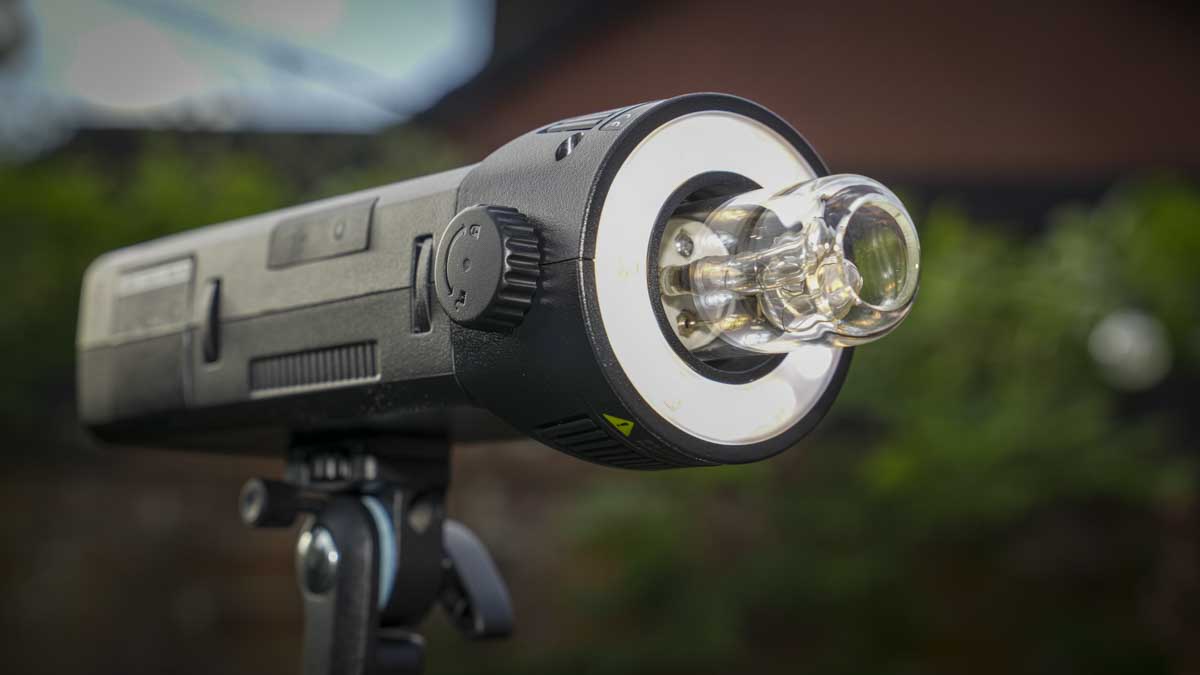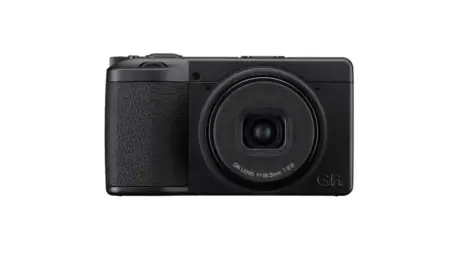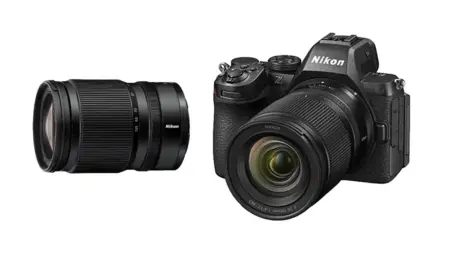Our Verdict
The Godox AD200 Pro II fills the lighting gap between hot shoe and studio flash with a unique wedge-like design that offers absolute versatility for your lighting setups, whether at an event or an outdoor fashion shoot.
In this test, I used the AD200 Pro II with the Sony A7 IV, combining it with the Godox X3s mounted onto the camera’s hot shoe, enabling a complete wireless control setup. Using just one AD200 Pro II with the X3 instantly gives you an idea of how powerful this setup could be with multiple flash units and the ability to switch in and adjust each through this one small wireless interface. However, in this review, I’m focusing on the actual AD200 Pro II.
The compact size and battery-powered portability of the AD200 Pro II suit on-location shoots, and it performs equally well in controlled studio settings. It should be pointed out that this is closer to a studio flash than a hot shoe, so there’s no direct way to mount this onto your camera. Instead, there’s a 1/4-inch thread on the base and a lighting stand mount in the case.
Adjusting settings directly on the flash is easy enough using the small rear screen, but again, having the X3 makes things just that touch easier with settings controls directly from the top of the camera. That connection is also needed if you wish to use TTL and some of the other more advanced features.
The power comes from the large rechargeable battery, and while this offers plenty of power, a couple of units is probably a good idea for a full day’s shoot. It’s also a shame that the unit can’t be charged directly through USB or powered with PD power.
In use, the AD200 Pro II truly bridges the gap between hot shoe and studio flash, offering both versatility and power. Overall, the AD200 Pro II provides excellent colour stability, fast recycling, and solid output adjustments, with the star feature being the small power increment adjustment, making it ideal for enthusiasts and pros who like to be flexible with their lighting choices.
What is the Godox AD200 Pro II?
The Godox AD200 Pro II is a unique, portable flash that combines aspects of both hot shoe and traditional studio flash systems, offering a powerful 200Ws output while remaining lightweight and battery-powered. Unlike standard hot shoe strobes, which typically provide around 75-100Ws and mount directly to a camera, the AD200 Pro II requires a wireless trigger. In this test, that trigger is the Godox X3s, which sits in the hot shoe of the Sony A7 IV to enable many of the more advanced features. While it’s a big step up from a hot shoe flash, it’s also far more compact and portable than a typical studio flash, making it versatile for on-location as well as a go-to for outdoor shoots.
Click here to buy the Godox AD200 Pro II from Amazon
The AD200 Pro II is designed for enthusiast and professional photographers, particularly those needing lighting that can handle both controlled studio environments and outdoor settings such as weddings and sports events. One feature that makes it highly versatile is its compatibility with camera systems’ TTL (Through-The-Lens metering) and High-Speed Sync (HSS) up to 1/8000s, which is where the Godox X3 comes into play. Besides its flash abilities, there’s also a bi-colour modeling lamp, which can double as a very versatile video lamp.

A key feature of the AD200 Pro II is that the heads can be changed, with a choice of two tailored for different environments: the Speedlite Flash H200 II and the Bare Bulb Flash Head H200J II, which also features a ring of bi-colour LEDs.
Specification
Build and Handling
At first, you could mistake the Godox AD200 Pro II for a large hot shoe flash, but as soon as you pick it up, you’ll see that it really is something different. First of all, there’s no hot shoe mount to attach the flash, and it’s a fixed rectangular unit with no articulation in any direction—where the flash head points is where the light will be thrown. In that sense, it’s much more like a studio flash.
The main body of the flash is made from ultra-tough polycarbonate, giving it a solid feel. While the finish is good, it doesn’t have the same high-quality flair or design as the Godox X3, although it is still very well-made.
In terms of size and weight, it measures 210x53x76mm and weighs 916g, so it fits comfortably in hand. With the lighting stand adapter, it’s easy to mount and move around in and out of a studio environment. There’s also a 1/4-inch thread on the base, allowing it to be bolted into a tripod or accessory arm if the lighting stand adapter isn’t used.
On the back is a small screen that enables quick access to and navigation of settings. It’s relatively easy to use, and with the four buttons and dial with set button, it all starts to make sense after a couple of uses. If you’re using this in isolation with the wireless flash trigger, it’s simple, but complexity is inevitable as more flashes are added.
Overall, this control layout on the back is user-friendly, with well-spaced buttons that make in-hand adjustments straightforward. While you can adjust all the settings through this interface on the back of the AD200 Pro II, it has been designed to integrate seamlessly with Godox’s 2.4G wireless system and supports the Godox X3 trigger. Once synced with this system, which Godox has made nice and easy, it’s possible to adjust light output remotely from the camera without needing direct TTL controls on the flash.
Click here to buy the Godox AD200 Pro II from Amazon
Power for the AD200 Pro II is supplied by a 14.4V/2900mAh lithium-ion battery, which charges fully in about 2 hours and delivers up to 500 full-power flashes per charge. This battery is removable, so a couple of packs will easily see you through most sessions. If you need more power, the flash is compatible with the Godox PB960 power pack. Unfortunately, there’s no PD power option for keeping the power topped up through a shoot or charging the batteries; it requires its own proprietary charger.
One of the standout features of the AD200 Pro II is that it includes two heads: a Fresnel speedlite head for directional light and a bare-bulb head that disperses a soft, 360-degree spread—ideal for modifiers such as softboxes and diffusers. Both heads feature an upgraded bi-colour modelling lamp, adjustable from 2800K to 6000K, which also enables it for video use, providing continuous light with flexible temperature settings to match ambient lighting or allow for creative lighting effects.
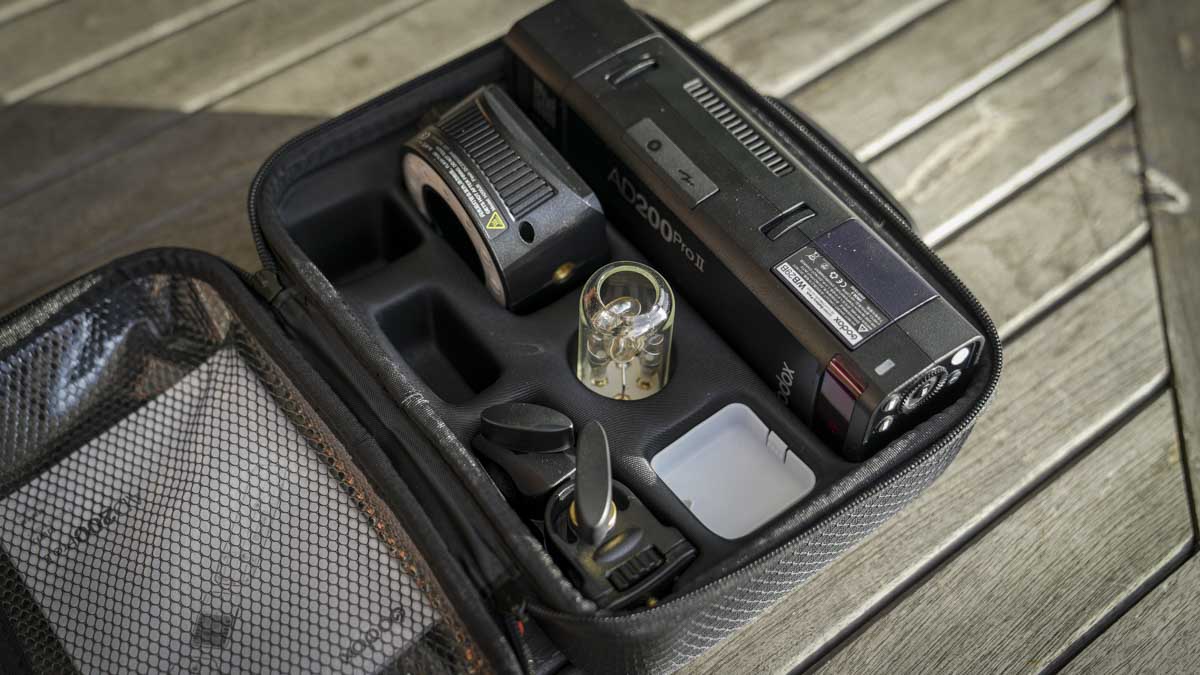
While the flash itself has an industrial look, a range of accessories is available, with the Bowens mount adapter opening up many options for this compact flash solution. Other Godox light modifiers—including beauty dishes, barn doors, and grids—give you plenty of options for different shooting styles and lighting effects. This compatibility with accessories from both Godox and third parties makes it suitable for portraits, product shots, and environmental photography, where flexible light shaping is key.
Features
The Godox AD200 Pro II is designed with a powerful and versatile feature set that makes it a great solution for a wide range of photography setups, whether out in the field shooting events or at a more subdued pace in the studio. At its core, the AD200 Pro II offers 200Ws flash power with a nine-stop range from 1/1 to 1/512, enabling you to fine-tune the lighting power on your subjects.
What really makes this system unique is the two-head system, allowing you to quickly swap to your head of choice: a bare-bulb head for softer, omnidirectional light suitable for broad diffusion (such as softbox use) and a speedlite-style Fresnel head for more focused, direct lighting that works well for both portraits and action shots.
Included in the kit are the flash unit, both the Fresnel and bare-bulb heads, a battery and charger, and a protective case, providing everything you need to get started and should suffice for most lighting scenarios straight out of the box.

One aspect I really appreciate about the unit’s features is the bi-colour modelling lamp, which ranges from 2800K to 6000K. This provides continuous light for video or previewing lighting setups and is available for both heads, with adjustable brightness to match ambient lighting.
For connectivity, the AD200 Pro II pairs with the Godox X3 trigger. In this test, I’m using the Sony A7 IV, coupled with the Godox X3S wireless trigger, enabling wireless remote control up to 100 metres. The X3, or X3S in this review (S being the Sony version), along with Godox’s 2.4GHz wireless system, enables integration with multiple flashes in complex setups, including compatibility with other Godox lights like the V1, AD300, and AD400Pro.
The high compatibility allows you to mix and match solutions easily, ensuring integration into multi-light environments as well as support for other Godox flashes.
Other notable features include High-Speed Sync (HSS) up to 1/8000s, front and rear curtain sync, and a colour stability mode, which maintains consistency within a ±100K temperature range across power settings—a feature essential for product and fashion photography that requires precise colour matching.

For extended sessions, the AD200 Pro II supports connection to the optional Godox PB960 power pack. This relatively compact power pack can deliver the power needed to keep pace with studio sessions.
Performance
The Godox AD200 Pro II is a high-performing flash, designed for both handheld and stand-mounted use. It’s easy to set up, and the swappable heads are simple to change out; throughout the test, switching from one head to the other was effortless. You can switch between a directional speedlite head and a 360-degree bare-bulb for softer light within a few seconds. Both heads offer 200Ws power output, adjustable down to 1/512, which is far more range than I’m used to and proved extremely useful, providing substantial flexibility in fine-tuning light levels.
One important aspect to mention right from the start is that the AD200 Pro II doesn’t work in isolation; it needs to be used with a trigger, unless you wire it in, of course. The easiest option is the Godox X3 trigger, which enables seamless wireless control that can be set up within seconds. Godox has streamlined the process so that you simply select wireless sync on both the flash and the X3, then press OK, and you’re done. If you have additional units, you do the same, and each can then be adjusted and fired directly from the small X3 unit. When it comes to wireless flash triggers, the X3 is as close to perfection as you can get, and considering its functionality, it’s very affordable.

Swapping heads, batteries, and connections are all well-catered for, and when it comes to mounting, Godox has focused on functionality with two 1/4-inch threads—one on the base and the other on the side—to enable easy mounting to any support or stand. There’s also a lighting stand adapter included in the case.
During the test, flash performance was consistent, and firing the flash 50 times at a white background showed that colour accuracy is reliably consistent, with colour stability maintained across varied power outputs. Recycle times are also decent (1.8s at full power), and the bi-colour modelling lamp with adjustable brightness proves surprisingly effective for video work, though its brightness won’t replace a dedicated continuous light in all settings.
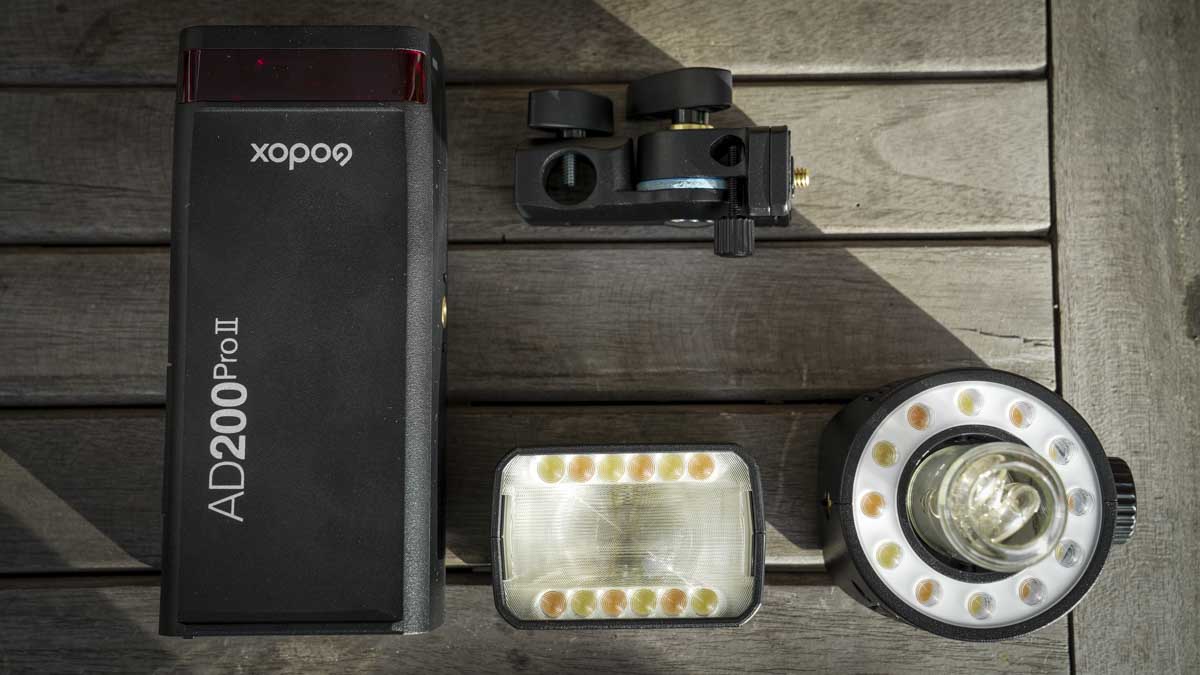
As the test went on and the flash was used in a variety of different shoots, you start to realise just how good this system is. At 200Ws, it’s powerful and versatile for its size. One unit is good, but the potential of five of these flashes could be transformative for serious professional and creative work. While the raw power is impressive, it’s the subtle adjustment of power that makes this unit something different, more creatively powerful than any other system I’ve used. When I reviewed the X3, I saw the potential, but it’s only when it’s coupled with the AD200 Pro II that you really see what’s possible.
However, despite its brilliance, there are still areas that don’t feel as well-balanced. The design is one of those things: the X3 is beautiful, well-designed, and feels premium, while the AD200 Pro II is more of a mix. Then there’s the battery, which is proprietary and provides up to 500 full-power flashes per charge but requires a dedicated charger rather than any direct USB charging option. I have lots of gear for different situations, and now all camera batteries are replaced with ones that charge through USB; likewise, all V-Mount, lights, mics, etc., for my personal gear utilise a single charging cable type. Like many others, I now appreciate the convenience of USB charging. However, there is the option of external power via the Godox PB960 pack for extended sessions, so as long as that offers 100W PD power, I’m happy.

The size, power, and adaptability are all great, but what is really important to me is compatibility. The fact that there’s a direct adapter enabling Bowens mount light modifiers to be attached just finishes things off nicely, even if this is an additional purchase.
Final Thoughts
The Godox AD200 Pro II is an impressive piece of kit that offers a compact, powerful lighting solution for both photographers and videographers. Its small size and weight make it extremely versatile, allowing it to be used on-location or equally in a studio setup.
Click here to buy the Godox AD200 Pro II from Amazon
The AD200 Pro II’s portability and robust build are complemented by a quick wireless pairing feature through the Godox X3 trigger, which makes it simple to integrate into multi-light configurations. I do wish that Godox had refined the design of the flash a little more to meet the high quality of the X3. However, while I might not be 100% sold on the aesthetics, it’s hard to argue with the functionality. The flash’s 200Ws output power and bi-colour modelling lamp deliver excellent and reliable performance across a variety of situations, providing light in ways that few, if any, other flashes can. The fact that one unit provides such a powerful solution only hints at what would be possible with more.

While its battery-dependent design and compact screen might feel limiting in extended sessions, the AD200 Pro II compensates with adaptable features and versatile power control options, ranging from 1/512 to full power. This is a feature that, for me, really stands out. This range allows micro-adjustments that should meet any of your lighting needs, whether for portraits, events, or product photography. With support for High-Speed Sync (up to 1/8000s), Bowens mount compatibility (via adapter), and compatibility with the Godox PB960 power pack, this flash is an excellent choice for high-end enthusiasts and professionals who demand flexibility, power, and high colour accuracy from their lighting gear.

